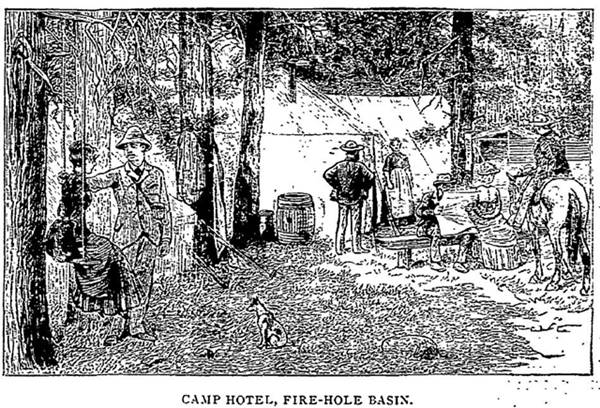Brief History of the transportation operations in Yellowstone National Park
Copyright 2018 Robert V. Goss
|
The earliest commercial transportation venture in the Park was Jack Baronett`s toll bridge, built in 1871 near Tower junction over the Yellowstone River. Baronett, who had prospected for gold in the park as early as 1864, built a cabin on the bench above the junction of the Lamar and Yellowstone Rivers, and charged a $1.00 a head for man or beast to cross. The bridge was built originally to serve the traffic to and from the Cooke City gold mines and lasted until 1903 when a new bridge was constructed a short distance upstream
Wm. H. Jackson photo, 1871, Authors Collection
|
 |
| In 1873, John Werks, George Huston, and Frank Grounds operated a primitive pack and saddle business at Mammoth Hot Springs that carried tourist into the heart of Wonderland. They were served by G.W.A Frazier's stages from Bozeman to Mammoth. In 1874-75, stagecoach service to Yellowstone was supplied by 'Zack Roots Express` weekly service from Bozeman to Mammoth. The stage left Bozeman on Mondays, arriving at Mammoth on Tuesdays and connected with Huston’s pack train operation. The service carried mail, freight, and passengers. There appears to be no advertisement for the Zack Root operation after 1875. In 1876, George Ash and Edward L. Fridley were operating Ash & Fridley’s stage line from Bozeman to Mammoth. G.W. Reese seemed to take over the route in 1877 and was operating the Clark’s Fork Express line, from Bozeman to Bear Gulch (Jardine), Cooke City area, and Mammoth Springs. Again, there seem to be no ads for the following year. |
|
The construction of a primitive road by Park Supt. Philetus Norris and his crew from Mammoth to the Lower Geyser Basin (Old Faithful area) in 1878 opened up the park to visitors using wagons or coaches, rather than just horse or pack animals. This convinced Marshall & Goff to initiate a stagecoach business in 1880 to access the Geyser Basins and Marshall`s Hotel from Virginia City. In 1883 the Yellowstone Park Association opened hotel operations at Old Faithful, Lake, Canyon and Mammoth. They contracted with Wakefield & Hoffman to provide stage service from Cinnabar, where the Northern Pacific RR had just opened a branch line from Livingston, to all the hotels in the park.
|
Marshall's Hotel and Stage Operation
Montana and Yellowstone National Park, by Robert E. Strahorn, 1881
|
Tent Hotel at Canyon ca1887
Notre Dame Scholastic, 1888
|
 Tent Hotel at Fire-Hole ca1887
Tent Hotel at Fire-Hole ca1887
Notre Dame Scholastic, 1888 |
National Hotel at Mammoth ca1887
Notre Dame Scholastic, 1889
|
|
During the next 36 years numerous companies operated stagecoach lines, including, Yellowstone Transportation Co., Yellowstone National Park Transportation Co., Yellowstone Park Transportation Co., Monida & Yellowstone Stage Co. (F.J. Haynes), Yellowstone & Western Stage Co., Holm Camping & Transportation Co., Cody-Sylvan Pass Co., Wylie Camping Co., and the Shaw & Powell Camping Co.
[Photos courtesy of the author's collection]
|
|
|
|
|
|
| In August of 1915, automobiles were first allowed into the Park. That year and the following one was a time of transition with both modes of travel operating under strict guidelines. After the 1916 season, all stagecoach transportation companies were merged into a monopoly called the Yellowstone Park Transportation Co. under Harry W. Child. The noble steeds and quaint coaches of yesteryear were put out to pasture and replaced with White Motor Company buses. With this change, came major changes to the entire way of doing business in the Park. Shortened travel times were now available, so hotels were no longer needed at Fountain, Norris and West Thumb. Many tent camps were also closed to eliminate duplication of services. The quicker travel times and increased freight tonnage available with motorized trucks eliminated the need for the various dairy and slaughterhouse operations inside the Park. Also, with the elimination of the "weed-burners`, the park`s pastures would no longer be needed for the intense grazing that had been necessary. |

1917 Newspaper Article, Author's Collection
|
|
Harry Child, with loans of over $400,000 from the railroads, purchased 117 White Motor buses and various service trucks. These were headquartered at the barns built in 1903-04 at Mammoth. Plans were finalized for new facilities in Gardiner in 1924, but in March of 1925, the buildings at Mammoth burned, along with at least 93 vehicles. It took a giant effort by the White Motor Company to get new auto stages to the park for spring opening. In 1936 the YPTC was merged with other park concessionaires into the Yellowstone Park Company under Wm. Nichols, Harry Child`s son-in-law. As automobiles took over, the need for improvement of the roadbeds became a priority. Gradually, the roads were widened, oiled, graveled, and ultimately paved, while bridges were widened and improved. The need for auto campgrounds and gas filling stations also became apparent, and eventually facilities were established at all major locations.
|
YPTCo Letterhead, 1923
Author's Collcetion
|
Copyright 2018 Robert V. Goss
All rights reserved. No part of this work may be reproduced or utilized in any form by any means,
electronic or mechanical, including photocopying, recording or by an information storage and
retrieval system without permission in writing from the author.
|